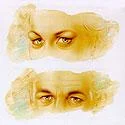More than any other facial feature, your eyes reveal the most about how you feel. You appear energized, well-rested, and in control when your eyes are bright and alert. However, if you have lower eyelid puffiness, dark circles, or drooping upper lids, others may assume that you are tired, angry, or unhappy.
If you believe that your eyes are making you look tired, sad, or older than you really feel, cosmetic eyelid surgery (also called blepharoplasty) may be the right choice. (See Figure A.) Eyelid surgery can remove the excess fat and drooping skin of the upper eyelids, minimize bags under the eyes and tighten the lower eyelid skin. The result is a more alert and rested appearance.
IS COSMETIC EYELID SURGERY RIGHT FOR ME?
Eyelid surgery is performed on men and women of all ages who want to improve their self-image. Most people have eyelid surgery to minimize the effects of aging. However, many people in their 30s with congenital or excess eyelid fat may also benefit from the procedure.
You may be a good candidate for eyelid surgery if you have any of the following conditions:
Upper Eyelids
- Excess skin that hides the natural fold of the upper eyelids
- Loose skin that hangs down from the upper eyelids
- Puffiness in the upper eyelids that creates a tired look
Lower Eyelids
- Excess skin and fine wrinkles of the lower eyelids close to the eyelashes
- Puffy "bags" and, in some cases, dark circles
HOW IS COSMETIC EYELID SURGERY PERFORMED?
Your features will determine the specific method used for your eyelid surgery.
Upper Eyelids
Typically, the incision begins within the natural crease of the eye’s inside corner and extends slightly beyond the outside corner into the crow’s feet or laugh lines. Through this incision, excess skin and fatty tissue are removed. The incision line follows the natural contour of the upper eyelid, and is camouflaged when healed. (See Figures B and C.)
Lower Eyelids
Usually the incision is concealed just below the lower eyelashes. Through this incision, excess skin, muscle and fat are removed. In some patients, the underlying muscle will be tightened. Sometimes the best approach for removing fat from the lower eyelids is with a transconjunctival blepharoplasty. In this procedure, an incision is placed inside the lower eyelid. This technique requires no external incision, but it cannot be used to remove excess skin and therefore not all patients are candidates for this procedure.
HOW WILL I LOOK AND FEEL AFTER SURGERY?
Although everyone heals at a different rate, you can expect that your recovery will follow this general timeline:
The first day:
In this earliest stage of healing, it’s important to rest with your head elevated. Cold compresses on the eyes reduce swelling.
Within the first week:
Bruising around the eyes will reach its peak and then begin to fade. Mildly blurred vision, excess tearing or dryness, light sensitivity or itching may accompany healing. After a week, you can begin to use makeup to conceal any discoloration. Stitches will be removed. You may resume most of your normal (non-strenuous) activities. (See Figure D.)

FIGURE A
Eyelid puffiness, drooping upper lids or fine wrinkles around the eyelids can make people appear tired, sad, or older than they feel.

FIGURE B
Typically, incisions are made following your eye area's natural lines and creases and will be well-camouflaged when healed.

FIGURE C
Excess fat is removed or redistributed.

FIGURE D
After surgery, eyelids no longer droop and the skin under the eyes is smooth and firm.



